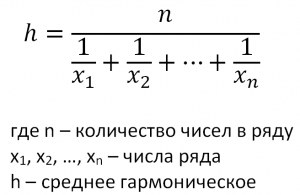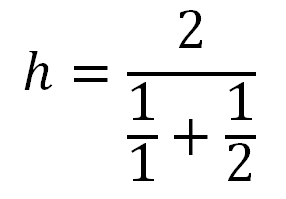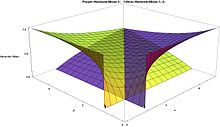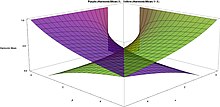Текущая версия страницы пока не проверялась опытными участниками и может значительно отличаться от версии, проверенной 14 ноября 2022 года; проверки требуют 2 правки.
Сре́днее гармони́ческое — один из способов, которым можно понимать «среднюю» величину некоторого набора чисел. Его можно определить следующим образом: пусть даны положительные числа 

-
.
Можно получить явную формулу для среднего гармонического:
-
,
т. е. среднее гармоническое есть обратная величина к среднему от обратных к числам 
Свойства[править | править код]
- Среднее гармоническое действительно является «средним», в том смысле что
.
- Вообще, среднее гармоническое является средним степени -1.
- Среднее гармоническое двойственно среднему арифметическому в следующем смысле:
-
и
(когда последнее определено).
- Неравенство о средних утверждает, что среднее гармоническое чисел не превосходит среднее геометрическое, среднее арифметическое и среднее квадратическое, причём все средние равны только в случае равенства всех чисел
то есть:
-
- где
— среднее гармоническое;
— среднее геометрическое;
— среднее арифметическое;
— среднее квадратическое.
Среднее гармоническое взвешенное[править | править код]
Пусть есть набор неотрицательных чисел 



Из формулы следует, что при 

У трапеции длина отрезка, проходящего через точку пересечения диагоналей параллельно основаниям, равна среднему гармоническому длин оснований[1]

Диаметры заполненных аквамариновым цветом кругов, называемых кругами-близнецами[en], одинаковые и равны среднему гармоническому радиусов полуокружностей, построенных на отрезках AB и BC как на диаметрах.
Приложения и примеры[править | править код]
В статистике среднее гармоническое применяется в случае, когда наблюдения, для которых требуется получить среднее арифметическое, заданы обратными значениями.
В формуле тонкой линзы удвоенное фокусное расстояние равно среднему гармоническому расстояния от линзы до предмета и расстояния от линзы до изображения. Подобным образом среднее гармоническое входит и в аналогичную формулу для сферического зеркала.
Средняя скорость на пути, разделенном на равные участки, скорость на которых постоянна, равна среднему гармоническому скоростей на этих участках пути. Более обще, если путь разбит на участки, скорость на каждом из которых постоянна, то средняя скорость будет равна взвешенному среднему гармоническому скоростей (каждая скорость идет с весом, равным длине соответствующего ей отрезка).
Средняя плотность сплава равна взвешенному среднему гармоническому плотностей сплавляемых веществ (веса — массы частей соответствующих веществ).
Сопротивление, получающееся при параллельном подключении нескольких резисторов, равно среднему гармоническому их сопротивлений, деленному на их количество. Аналогичное утверждение верно для емкостей последовательно соединенных конденсаторов.
Примечания[править | править код]
- ↑ Роу С. Геометрические упражнения с куском бумаги. — 2-е изд. — Одесса: Матезис, 1923. — С. 65. Архивная копия от 24 мая 2012 на Wayback Machine
См. также[править | править код]
- Гармоническая пропорция
- Гармонический ряд
Ссылки[править | править код]
- Weisstein, Eric W. Harmonic Mean / MathWorld–A Wolfram Web Resource

Среднее гармоническое
Среднее гармоническое — один из способов определения среднего значения числового ряда (наряду с медианой и средним арифметическим). Мы сделали калькулятор, который может рассчитать среднее гармоническое двух, трех — да любого количества чисел.
Рассчитывается среднее гармоническое по простой формуле и является обратной величиной к среднему от обратных к числам.
Среднее гармоническое удобно применять для решения задач, которые начинаются словами «первую половину пути автомобиль проехал со скоростью…». Например, первую половину пути автомобиль проехал со скоростью 60 км/ч вторую 90 км/ч. Найдите среднюю скорость. Просто введите в калькулятор два числа — 60 и 90 и получите ответ — 72 км/ч.
Калькулятор среднего гармонического
Как найти среднее гармоническое чисел
Лучше показать это на примере. Найдем среднее гармоническое двух чисел 1 и 2. Подставив значения в формулу получим такое выражение:

Здесь в числителе количество чисел (2), а в знаменателе сами числа. В результате расчета получаем, что среднее геометрическое чисел 1 и 2 равно 1,6666… или 1,(6).
Ваша оценка
[Оценок: 163 Средняя: 3.2]
Среднее гармоническое Автор admin средний рейтинг 3.2/5 – 163 рейтинги пользователей
Онлайн калькулятор для расчета среднего гармонического двух, трех, четырех и более чисел. Средняя гармоническая величина ( или Среднее гармоническое ) получается от деления числа данных величин на сумму величин обратных данным.
Формулы для нахождения среднего гармонического: 
Формула средней гармонической взвешенной:

×
Пожалуйста напишите с чем связна такая низкая оценка:
×
Для установки калькулятора на iPhone – просто добавьте страницу
«На главный экран»

Для установки калькулятора на Android – просто добавьте страницу
«На главный экран»

Смотрите также
Среднее гармоническое
- Главная
- /
- Математика
- /
- Арифметика
- /
- Среднее гармоническое
Чтобы найти среднее гармоническое нескольких чисел воспользуйтесь нашим очень удобным онлайн калькулятором:
Онлайн калькулятор
Среднее гармоническое:
0
Округление ответа:
Просто введите положительные числа и получите среднее гармоническое этих чисел. Для того чтобы добавить в ряд более двух чисел воспользуйтесь зелёной кнопкой “+”.
Теория
Средним гармоническим H(X1,…,Xn) двух и более чисел является обратная величина к среднему арифметическому их обратных.
Формула
| H(x1,…,xn) | = | n |
| 1⁄x1 + 1⁄x2 + … + 1⁄xn |
Примеры
Для чего служит средняя гармоническая чисел? К примеру, для определения средней скорости:
Среднее гармоническое двух чисел
Представим, что автомобиль проехал некий путь, при этом первые полпути он ехал со скоростью 80 км/ч, а вторые полпути – со скоростью 20 км/ч. И нам надо определить его среднюю скорость. Для этого нам понадобится найти среднее гармоническое для двух чисел: 80 и 20.
| H(80, 20) | = | 2 | = | 2 | = 32 |
| 1⁄80 + 1⁄20 | 0.0125 + 0.05 |
Таким образом, средняя скорость автомобиля равна 32 км/ч.
Среднее гармоническое трех чисел
Если же наш автомобиль треть пути ехал со скоростью 80 км/ч, треть – со скоростью 20 км/ч и треть со скоростью 8 км/ч, то его среднюю скорость определяем так:
| H(80, 20, 8) | = | 3 | = | 3 | = 16 км/ч |
| 1⁄80 + 1⁄20 + 1⁄8 | 0.0125 + 0.05 + 0.125 |
См. также
In mathematics, the harmonic mean is one of several kinds of average, and in particular, one of the Pythagorean means. It is sometimes appropriate for situations when the average rate is desired.[1]
The harmonic mean can be expressed as the reciprocal of the arithmetic mean of the reciprocals of the given set of observations. As a simple example, the harmonic mean of 1, 4, and 4 is
Definition[edit]
The harmonic mean H of the positive real numbers

The third formula in the above equation expresses the harmonic mean as the reciprocal of the arithmetic mean of the reciprocals.
From the following formula:
it is more apparent that the harmonic mean is related to the arithmetic and geometric means. It is the reciprocal dual of the arithmetic mean for positive inputs:
The harmonic mean is a Schur-concave function, and dominated by the minimum of its arguments, in the sense that for any positive set of arguments, 
The harmonic mean is also concave, which is an even stronger property than Schur-concavity.
One has to take care to only use positive numbers though, since the mean fails to be concave if negative values are used.
Relationship with other means[edit]

The harmonic mean is one of the three Pythagorean means. For all positive data sets containing at least one pair of nonequal values, the harmonic mean is always the least of the three means,[2] while the arithmetic mean is always the greatest of the three and the geometric mean is always in between. (If all values in a nonempty dataset are equal, the three means are always equal to one another; e.g., the harmonic, geometric, and arithmetic means of {2, 2, 2} are all 2.)
It is the special case M−1 of the power mean:
Since the harmonic mean of a list of numbers tends strongly toward the least elements of the list, it tends (compared to the arithmetic mean) to mitigate the impact of large outliers and aggravate the impact of small ones.
The arithmetic mean is often mistakenly used in places calling for the harmonic mean.[3] In the speed example below for instance, the arithmetic mean of 40 is incorrect, and too big.
The harmonic mean is related to the other Pythagorean means, as seen in the equation below. This can be seen by interpreting the denominator to be the arithmetic mean of the product of numbers n times but each time omitting the j-th term. That is, for the first term, we multiply all n numbers except the first; for the second, we multiply all n numbers except the second; and so on. The numerator, excluding the n, which goes with the arithmetic mean, is the geometric mean to the power n. Thus the n-th harmonic mean is related to the n-th geometric and arithmetic means. The general formula is
If a set of non-identical numbers is subjected to a mean-preserving spread — that is, two or more elements of the set are “spread apart” from each other while leaving the arithmetic mean unchanged — then the harmonic mean always decreases.[4]
Harmonic mean of two or three numbers[edit]
Two numbers[edit]

For the special case of just two numbers, 

or
In this special case, the harmonic mean is related to the arithmetic mean 

Since 

Three numbers[edit]
For the special case of three numbers, 


Three positive numbers H, G, and A are respectively the harmonic, geometric, and arithmetic means of three positive numbers if and only if[5]: p.74, #1834 the following inequality holds
Weighted harmonic mean[edit]
If a set of weights 



The unweighted harmonic mean can be regarded as the special case where all of the weights are equal.
Examples[edit]
In physics[edit]
Average speed[edit]
In many situations involving rates and ratios, the harmonic mean provides the correct average. For instance, if a vehicle travels a certain distance d outbound at a speed x (e.g. 60 km/h) and returns the same distance at a speed y (e.g. 20 km/h), then its average speed is the harmonic mean of x and y (30 km/h), not the arithmetic mean (40 km/h). The total travel time is the same as if it had traveled the whole distance at that average speed. This can be proven as follows:[7]
Average speed for the entire journey
= Total distance traveled/Sum of time for each segment
= 2d/d/x + d/y = 2/1/x+1/y
However, if the vehicle travels for a certain amount of time at a speed x and then the same amount of time at a speed y, then its average speed is the arithmetic mean of x and y, which in the above example is 40 km/h.
Average speed for the entire journey
= Total distance traveled/Sum of time for each segment
= xt+yt/2t
= x+y/2
The same principle applies to more than two segments: given a series of sub-trips at different speeds, if each sub-trip covers the same distance, then the average speed is the harmonic mean of all the sub-trip speeds; and if each sub-trip takes the same amount of time, then the average speed is the arithmetic mean of all the sub-trip speeds. (If neither is the case, then a weighted harmonic mean or weighted arithmetic mean is needed. For the arithmetic mean, the speed of each portion of the trip is weighted by the duration of that portion, while for the harmonic mean, the corresponding weight is the distance. In both cases, the resulting formula reduces to dividing the total distance by the total time.)
However, one may avoid the use of the harmonic mean for the case of “weighting by distance”. Pose the problem as finding “slowness” of the trip where “slowness” (in hours per kilometre) is the inverse of speed. When trip slowness is found, invert it so as to find the “true” average trip speed. For each trip segment i, the slowness si = 1/speedi. Then take the weighted arithmetic mean of the si‘s weighted by their respective distances (optionally with the weights normalized so they sum to 1 by dividing them by trip length). This gives the true average slowness (in time per kilometre). It turns out that this procedure, which can be done with no knowledge of the harmonic mean, amounts to the same mathematical operations as one would use in solving this problem by using the harmonic mean. Thus it illustrates why the harmonic mean works in this case.
Density[edit]
Similarly, if one wishes to estimate the density of an alloy given the densities of its constituent elements and their mass fractions (or, equivalently, percentages by mass), then the predicted density of the alloy (exclusive of typically minor volume changes due to atom packing effects) is the weighted harmonic mean of the individual densities, weighted by mass, rather than the weighted arithmetic mean as one might at first expect. To use the weighted arithmetic mean, the densities would have to be weighted by volume. Applying dimensional analysis to the problem while labeling the mass units by element and making sure that only like element-masses cancel makes this clear.
Electricity[edit]
If one connects two electrical resistors in parallel, one having resistance x (e.g., 60 Ω) and one having resistance y (e.g., 40 Ω), then the effect is the same as if one had used two resistors with the same resistance, both equal to the harmonic mean of x and y (48 Ω): the equivalent resistance, in either case, is 24 Ω (one-half of the harmonic mean). This same principle applies to capacitors in series or to inductors in parallel.
However, if one connects the resistors in series, then the average resistance is the arithmetic mean of x and y (50 Ω), with total resistance equal to twice this, the sum of x and y (100 Ω). This principle applies to capacitors in parallel or to inductors in series.
As with the previous example, the same principle applies when more than two resistors, capacitors or inductors are connected, provided that all are in parallel or all are in series.
The “conductivity effective mass” of a semiconductor is also defined as the harmonic mean of the effective masses along the three crystallographic directions.[8]
Optics[edit]
As for other optic equations, the thin lens equation 1/f = 1/u + 1/v can be rewritten such that the focal length f is one-half of the harmonic mean of the distances of the subject u and object v from the lens.[9]
In finance[edit]
The weighted harmonic mean is the preferable method for averaging multiples, such as the price–earnings ratio (P/E). If these ratios are averaged using a weighted arithmetic mean, high data points are given greater weights than low data points. The weighted harmonic mean, on the other hand, correctly weights each data point.[10] The simple weighted arithmetic mean when applied to non-price normalized ratios such as the P/E is biased upwards and cannot be numerically justified, since it is based on equalized earnings; just as vehicles speeds cannot be averaged for a roundtrip journey (see above).[11]
For example, consider two firms, one with a market capitalization of $150 billion and earnings of $5 billion (P/E of 30) and one with a market capitalization of $1 billion and earnings of $1 million (P/E of 1000). Consider an index made of the two stocks, with 30% invested in the first and 70% invested in the second. We want to calculate the P/E ratio of this index.
Using the weighted arithmetic mean (incorrect):
Using the weighted harmonic mean (correct):
Thus, the correct P/E of 93.46 of this index can only be found using the weighted harmonic mean, while the weighted arithmetic mean will significantly overestimate it.
In geometry[edit]
In any triangle, the radius of the incircle is one-third of the harmonic mean of the altitudes.
For any point P on the minor arc BC of the circumcircle of an equilateral triangle ABC, with distances q and t from B and C respectively, and with the intersection of PA and BC being at a distance y from point P, we have that y is half the harmonic mean of q and t.[12]
In a right triangle with legs a and b and altitude h from the hypotenuse to the right angle, h² is half the harmonic mean of a² and b².[13][14]
Let t and s (t > s) be the sides of the two inscribed squares in a right triangle with hypotenuse c. Then s² equals half the harmonic mean of c² and t².
Let a trapezoid have vertices A, B, C, and D in sequence and have parallel sides AB and CD. Let E be the intersection of the diagonals, and let F be on side DA and G be on side BC such that FEG is parallel to AB and CD. Then FG is the harmonic mean of AB and DC. (This is provable using similar triangles.)

Crossed ladders. h is half the harmonic mean of A and B
One application of this trapezoid result is in the crossed ladders problem, where two ladders lie oppositely across an alley, each with feet at the base of one sidewall, with one leaning against a wall at height A and the other leaning against the opposite wall at height B, as shown. The ladders cross at a height of h above the alley floor. Then h is half the harmonic mean of A and B. This result still holds if the walls are slanted but still parallel and the “heights” A, B, and h are measured as distances from the floor along lines parallel to the walls. This can be proved easily using the area formula of a trapezoid and area addition formula.
In an ellipse, the semi-latus rectum (the distance from a focus to the ellipse along a line parallel to the minor axis) is the harmonic mean of the maximum and minimum distances of the ellipse from a focus.
In other sciences[edit]
In computer science, specifically information retrieval and machine learning, the harmonic mean of the precision (true positives per predicted positive) and the recall (true positives per real positive) is often used as an aggregated performance score for the evaluation of algorithms and systems: the F-score (or F-measure). This is used in information retrieval because only the positive class is of relevance, while number of negatives, in general, is large and unknown.[15] It is thus a trade-off as to whether the correct positive predictions should be measured in relation to the number of predicted positives or the number of real positives, so it is measured versus a putative number of positives that is an arithmetic mean of the two possible denominators.
A consequence arises from basic algebra in problems where people or systems work together. As an example, if a gas-powered pump can drain a pool in 4 hours and a battery-powered pump can drain the same pool in 6 hours, then it will take both pumps 6·4/6 + 4, which is equal to 2.4 hours, to drain the pool together. This is one-half of the harmonic mean of 6 and 4: 2·6·4/6 + 4 = 4.8. That is, the appropriate average for the two types of pump is the harmonic mean, and with one pair of pumps (two pumps), it takes half this harmonic mean time, while with two pairs of pumps (four pumps) it would take a quarter of this harmonic mean time.
In hydrology, the harmonic mean is similarly used to average hydraulic conductivity values for a flow that is perpendicular to layers (e.g., geologic or soil) – flow parallel to layers uses the arithmetic mean. This apparent difference in averaging is explained by the fact that hydrology uses conductivity, which is the inverse of resistivity.
In sabermetrics, a baseball player’s Power–speed number is the harmonic mean of their home run and stolen base totals.
In population genetics, the harmonic mean is used when calculating the effects of fluctuations in the census population size on the effective population size. The harmonic mean takes into account the fact that events such as population bottleneck increase the rate genetic drift and reduce the amount of genetic variation in the population. This is a result of the fact that following a bottleneck very few individuals contribute to the gene pool limiting the genetic variation present in the population for many generations to come.
When considering fuel economy in automobiles two measures are commonly used – miles per gallon (mpg), and litres per 100 km. As the dimensions of these quantities are the inverse of each other (one is distance per volume, the other volume per distance) when taking the mean value of the fuel economy of a range of cars one measure will produce the harmonic mean of the other – i.e., converting the mean value of fuel economy expressed in litres per 100 km to miles per gallon will produce the harmonic mean of the fuel economy expressed in miles per gallon. For calculating the average fuel consumption of a fleet of vehicles from the individual fuel consumptions, the harmonic mean should be used if the fleet uses miles per gallon, whereas the arithmetic mean should be used if the fleet uses litres per 100 km. In the USA the CAFE standards (the federal automobile fuel consumption standards) make use of the harmonic mean.
In chemistry and nuclear physics the average mass per particle of a mixture consisting of different species (e.g., molecules or isotopes) is given by the harmonic mean of the individual species’ masses weighted by their respective mass fraction.
Beta distribution[edit]

Harmonic mean for Beta distribution for 0 < α < 5 and 0 < β < 5
![]()
(Mean – HarmonicMean) for Beta distribution versus alpha and beta from 0 to 2

Harmonic Means for Beta distribution Purple=H(X), Yellow=H(1-X), smaller values alpha and beta in front

Harmonic Means for Beta distribution Purple=H(X), Yellow=H(1-X), larger values alpha and beta in front
The harmonic mean of a beta distribution with shape parameters α and β is:
The harmonic mean with α < 1 is undefined because its defining expression is not bounded in [0, 1].
Letting α = β
showing that for α = β the harmonic mean ranges from 0 for α = β = 1, to 1/2 for α = β → ∞.
The following are the limits with one parameter finite (non-zero) and the other parameter approaching these limits:
With the geometric mean the harmonic mean may be useful in maximum likelihood estimation in the four parameter case.
A second harmonic mean (H1 − X) also exists for this distribution
This harmonic mean with β < 1 is undefined because its defining expression is not bounded in [ 0, 1 ].
Letting α = β in the above expression
showing that for α = β the harmonic mean ranges from 0, for α = β = 1, to 1/2, for α = β → ∞.
The following are the limits with one parameter finite (non zero) and the other approaching these limits:
Although both harmonic means are asymmetric, when α = β the two means are equal.
Lognormal distribution[edit]
The harmonic mean ( H ) of the lognormal distribution of a random variable X is[16]
where μ and σ2 are the parameters of the distribution, i.e. the mean and variance of the distribution of the natural logarithm of X.
The harmonic and arithmetic means of the distribution are related by
where Cv and μ* are the coefficient of variation and the mean of the distribution respectively..
The geometric (G), arithmetic and harmonic means of the distribution are related by[17]
Pareto distribution[edit]
The harmonic mean of type 1 Pareto distribution is[18]
where k is the scale parameter and α is the shape parameter.
Statistics[edit]
For a random sample, the harmonic mean is calculated as above. Both the mean and the variance may be infinite (if it includes at least one term of the form 1/0).
Sample distributions of mean and variance[edit]
The mean of the sample m is asymptotically distributed normally with variance s2.
The variance of the mean itself is[19]
where m is the arithmetic mean of the reciprocals, x are the variates, n is the population size and E is the expectation operator.
Delta method[edit]
Assuming that the variance is not infinite and that the central limit theorem applies to the sample then using the delta method, the variance is
where H is the harmonic mean, m is the arithmetic mean of the reciprocals
s2 is the variance of the reciprocals of the data
and n is the number of data points in the sample.
Jackknife method[edit]
A jackknife method of estimating the variance is possible if the mean is known.[20] This method is the usual ‘delete 1’ rather than the ‘delete m’ version.
This method first requires the computation of the mean of the sample (m)
where x are the sample values.
A series of value wi is then computed where
The mean (h) of the wi is then taken:
The variance of the mean is
Significance testing and confidence intervals for the mean can then be estimated with the t test.
Size biased sampling[edit]
Assume a random variate has a distribution f( x ). Assume also that the likelihood of a variate being chosen is proportional to its value. This is known as length based or size biased sampling.
Let μ be the mean of the population. Then the probability density function f*( x ) of the size biased population is
The expectation of this length biased distribution E*( x ) is[19]
where σ2 is the variance.
The expectation of the harmonic mean is the same as the non-length biased version E( x )
The problem of length biased sampling arises in a number of areas including textile manufacture[21] pedigree analysis[22] and survival analysis[23]
Akman et al. have developed a test for the detection of length based bias in samples.[24]
Shifted variables[edit]
If X is a positive random variable and q > 0 then for all ε > 0[25]
Moments[edit]
Assuming that X and E(X) are > 0 then[25]
This follows from Jensen’s inequality.
Gurland has shown that[26] for a distribution that takes only positive values, for any n > 0
Under some conditions[27]
where ~ means approximately equal to.
Sampling properties[edit]
Assuming that the variates (x) are drawn from a lognormal distribution there are several possible estimators for H:
where
Of these H3 is probably the best estimator for samples of 25 or more.[28]
Bias and variance estimators[edit]
A first order approximation to the bias and variance of H1 are[29]
where Cv is the coefficient of variation.
Similarly a first order approximation to the bias and variance of H3 are[29]
In numerical experiments H3 is generally a superior estimator of the harmonic mean than H1.[29] H2 produces estimates that are largely similar to H1.
Notes[edit]
The Environmental Protection Agency recommends the use of the harmonic mean in setting maximum toxin levels in water.[30]
In geophysical reservoir engineering studies, the harmonic mean is widely used.[31]
See also[edit]
- Contraharmonic mean
- Generalized mean
- Harmonic number
- Rate (mathematics)
- Weighted mean
- Parallel summation
- Geometric mean
- Weighted geometric mean
- HM-GM-AM-QM inequalities
- Harmonic mean p-value
Notes[edit]
- ^ If AC = a and BC = b. OC = AM of a and b, and radius r = QO = OG.
Using Pythagoras’ theorem, QC² = QO² + OC² ∴ QC = √QO² + OC² = QM.
Using Pythagoras’ theorem, OC² = OG² + GC² ∴ GC = √OC² − OG² = GM.
Using similar triangles, HC/GC = GC/OC ∴ HC = GC²/OC = HM.
References[edit]
- ^ https://www.comap.com/FloydVest/Course/PDF/Cons25PO.pdf Archived 2022-07-11 at the Wayback Machine[bare URL PDF]
- ^ Da-Feng Xia, Sen-Lin Xu, and Feng Qi, “A proof of the arithmetic mean-geometric mean-harmonic mean inequalities”, RGMIA Research Report Collection, vol. 2, no. 1, 1999, http://ajmaa.org/RGMIA/papers/v2n1/v2n1-10.pdf Archived 2015-12-22 at the Wayback Machine
- ^ *Statistical Analysis, Ya-lun Chou, Holt International, 1969, ISBN 0030730953
- ^ Mitchell, Douglas W., “More on spreads and non-arithmetic means,” The Mathematical Gazette 88, March 2004, 142–144.
- ^ Inequalities proposed in “Crux Mathematicorum”, “Archived copy” (PDF). Archived (PDF) from the original on 2014-10-15. Retrieved 2014-09-09.
{{cite web}}: CS1 maint: archived copy as title (link). - ^ Ferger F (1931) The nature and use of the harmonic mean. Journal of the
American Statistical Association 26(173) 36-40 - ^ “Average: How to calculate Average, Formula, Weighted average”. learningpundits.com. Archived from the original on 29 December 2017. Retrieved 8 May 2018.
- ^ “Effective mass in semiconductors”. ecee.colorado.edu. Archived from the original on 20 October 2017. Retrieved 8 May 2018.
- ^ Hecht, Eugene (2002). Optics (4th ed.). Addison Wesley. p. 168. ISBN 978-0805385663.
- ^ “Fairness Opinions: Common Errors and Omissions”. The Handbook of Business Valuation and Intellectual Property Analysis. McGraw Hill. 2004. ISBN 0-07-142967-0.
- ^ Agrrawal, Pankaj; Borgman, Richard; Clark, John M.; Strong, Robert (2010). “Using the Price-to-Earnings Harmonic Mean to Improve Firm Valuation Estimates”. Journal of Financial Education. 36 (3–4): 98–110. JSTOR 41948650. SSRN 2621087.
- ^ Posamentier, Alfred S.; Salkind, Charles T. (1996). Challenging Problems in Geometry (Second ed.). Dover. p. 172. ISBN 0-486-69154-3.
- ^ Voles, Roger, “Integer solutions of
,” Mathematical Gazette 83, July 1999, 269–271.
- ^ Richinick, Jennifer, “The upside-down Pythagorean Theorem,” Mathematical Gazette 92, July 2008, 313–;317.
- ^ Van Rijsbergen, C. J. (1979). Information Retrieval (2nd ed.). Butterworth. Archived from the original on 2005-04-06.
- ^ Aitchison J, Brown JAC (1969). The lognormal distribution with special reference to its uses in economics. Cambridge University Press, New York
- ^ Rossman LA (1990) Design stream flows based on harmonic means. J Hydr Eng ASCE 116(7) 946–950
- ^ Johnson NL, Kotz S, Balakrishnan N (1994) Continuous univariate distributions Vol 1. Wiley Series in Probability and Statistics.
- ^ a b Zelen M (1972) Length-biased sampling and biomedical problems. In: Biometric Society Meeting, Dallas, Texas
- ^ Lam FC (1985) Estimate of variance for harmonic mean half lives. J Pharm Sci 74(2) 229-231
- ^ Cox DR (1969) Some sampling problems in technology. In: New developments in survey sampling. U.L. Johnson, H Smith eds. New York: Wiley Interscience
- ^ Davidov O, Zelen M (2001) Referent sampling, family history and relative risk: the role of length‐biased sampling. Biostat 2(2): 173-181 doi:10.1093/biostatistics/2.2.173
- ^ Zelen M, Feinleib M (1969) On the theory of screening for chronic diseases. Biometrika 56: 601-614
- ^ Akman O, Gamage J, Jannot J, Juliano S, Thurman A, Whitman D (2007) A simple test for detection of length-biased sampling. J Biostats 1 (2) 189-195
- ^ a b Chuen-Teck See, Chen J (2008) Convex functions of random variables. J Inequal Pure Appl Math 9 (3) Art 80
- ^ Gurland J (1967) An inequality satisfied by the expectation of the reciprocal of a random variable. The American Statistician. 21 (2) 24
- ^ Sung SH (2010) On inverse moments for a class of nonnegative random variables. J Inequal Applic doi:10.1155/2010/823767
- ^ Stedinger JR (1980) Fitting lognormal distributions to hydrologic data. Water Resour Res 16(3) 481–490
- ^ a b c Limbrunner JF, Vogel RM, Brown LC (2000) Estimation of harmonic mean of a lognormal variable. J Hydrol Eng 5(1) 59-66 “Archived copy” (PDF). Archived from the original (PDF) on 2010-06-11. Retrieved 2012-09-16.
{{cite web}}: CS1 maint: archived copy as title (link) - ^ EPA (1991) Technical support document for water quality-based toxics control. EPA/505/2-90-001. Office of Water
- ^ Muskat M (1937) The flow of homogeneous fluids through porous media. McGraw-Hill, New York
External links[edit]
- Weisstein, Eric W. “Harmonic Mean”. MathWorld.
- Averages, Arithmetic and Harmonic Means at cut-the-knot

























![{displaystyle s^{2}={frac {mleft[operatorname {E} left({frac {1}{x}}-1right)right]}{m^{2}n}}}](https://wikimedia.org/api/rest_v1/media/math/render/svg/f1b0e55d7544440a9fbd2a87ffc9af57e2ba8a9d)
![{displaystyle operatorname {Var} left({frac {1}{x}}right)={frac {mleft[operatorname {E} left({frac {1}{x}}-1right)right]}{nm^{2}}}}](https://wikimedia.org/api/rest_v1/media/math/render/svg/7f042a71be3e7ecb7c7cda0c8bdee74b235eb26a)








![{displaystyle operatorname {E} ^{*}(x)=mu left[1+{frac {sigma ^{2}}{mu ^{2}}}right]}](https://wikimedia.org/api/rest_v1/media/math/render/svg/04ebd1c0379615420e7f13c5e8792657fb9b00a9)

![{displaystyle operatorname {Var} left[{frac {1}{(X+epsilon )^{q}}}right]<operatorname {Var} left({frac {1}{X^{q}}}right).}](https://wikimedia.org/api/rest_v1/media/math/render/svg/04b1ed002c8fea17b775c8720a911c8672f5b40d)
![{displaystyle operatorname {E} left[{frac {1}{X}}right]geq {frac {1}{operatorname {E} (X)}}}](https://wikimedia.org/api/rest_v1/media/math/render/svg/3f7988f06e7111c6fed5ea99836aa63995340a0d)


![{displaystyle {begin{aligned}H_{1}&={frac {n}{sum left({frac {1}{x}}right)}}\H_{2}&={frac {left(exp left[{frac {1}{n}}sum log _{e}(x)right]right)^{2}}{{frac {1}{n}}sum (x)}}\H_{3}&=exp left(m-{frac {1}{2}}s^{2}right)end{aligned}}}](https://wikimedia.org/api/rest_v1/media/math/render/svg/1cf33165a1fc67ba74ef984fc013c48c609e7181)


![{displaystyle {begin{aligned}operatorname {bias} left[H_{1}right]&={frac {HC_{v}}{n}}\operatorname {Var} left[H_{1}right]&={frac {H^{2}C_{v}}{n}}end{aligned}}}](https://wikimedia.org/api/rest_v1/media/math/render/svg/95e4b434476bf57bce386bb9c7619ba313f12469)
![{displaystyle {begin{aligned}{frac {Hlog _{e}left(1+C_{v}right)}{2n}}left[1+{frac {1+C_{v}^{2}}{2}}right]\{frac {Hlog _{e}left(1+C_{v}right)}{n}}left[1+{frac {1+C_{v}^{2}}{4}}right]end{aligned}}}](https://wikimedia.org/api/rest_v1/media/math/render/svg/a7090e6c7c0577560e9c3883547c4381fd0d6dc4)
